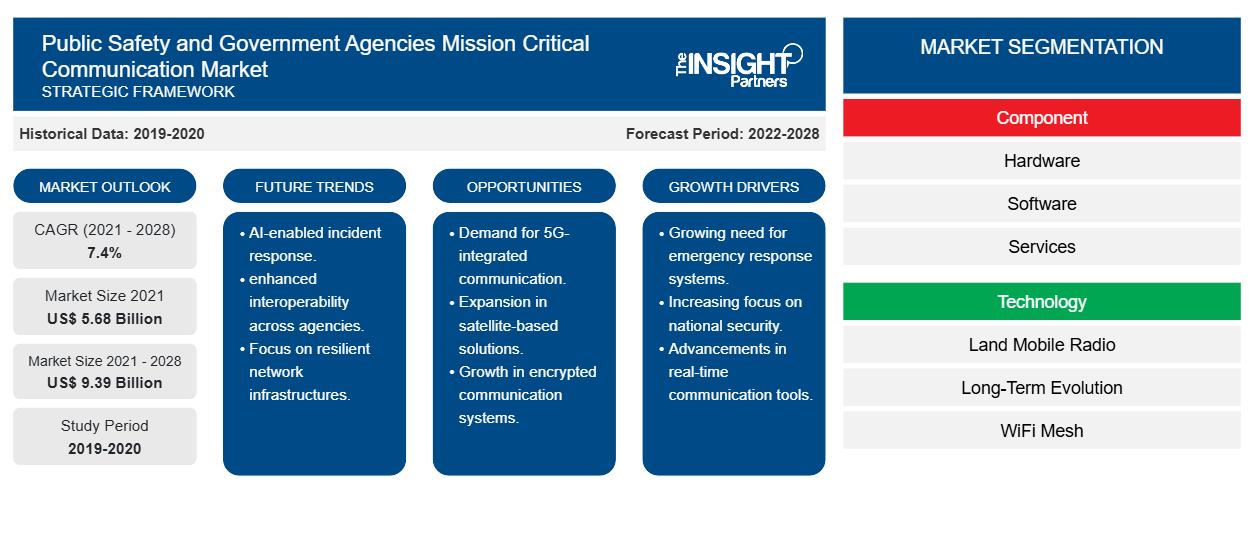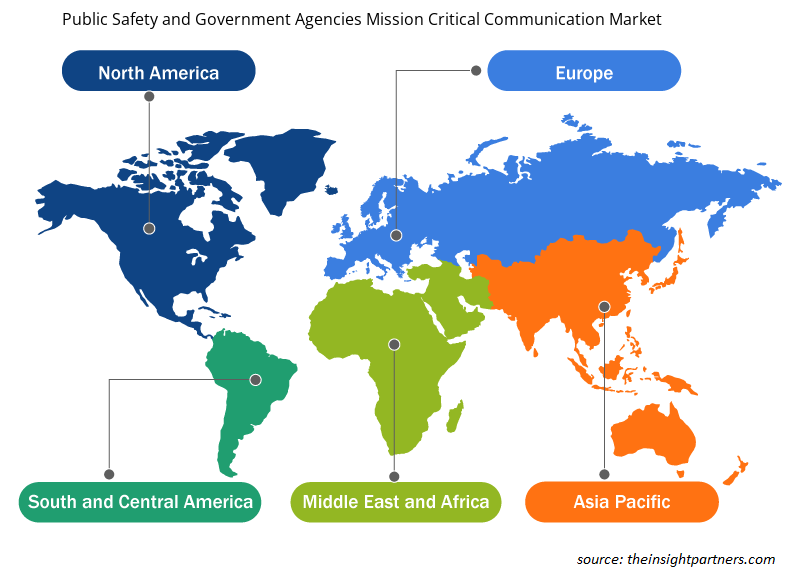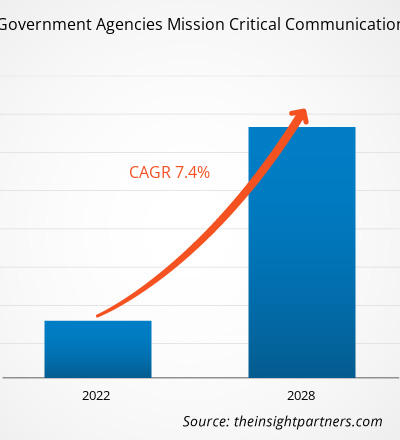El mercado de comunicaciones de misión crítica para agencias gubernamentales y de seguridad pública se valoró en US$ 5.684,3 millones en 2021 y se proyecta que alcance los US$ 9.390,0 millones en 2028; se espera que crezca a una CAGR del 7,4% entre 2021 y 2028.
Una comunicación de misión crítica implica soluciones que ayudan a los métodos de comunicación a los usuarios finales en situaciones en las que los sistemas tradicionales no satisfacen sus demandas. Además, el mercado de comunicaciones de misión crítica de agencias gubernamentales y de seguridad pública facilita la comunicación y respalda las operaciones que están plagadas de peligros para las personas y la propiedad. Los dispositivos de comunicación cruciales se utilizan para educar a las personas sobre las situaciones críticas. En el mercado de comunicaciones de misión crítica de agencias gubernamentales y de seguridad pública , los operadores de red se centran en nuevas estrategias de diseño y gestión para la infraestructura de comunicaciones para responder a la rápida evolución de la red y el servicio para garantizar un funcionamiento confiable de la red.
Impacto de la pandemia de COVID-19 en la seguridad pública y el mercado de comunicaciones de misión crítica de agencias gubernamentales
La epidemia de COVID-19 afectó significativamente al mercado de comunicaciones críticas para la seguridad pública y las agencias gubernamentales en América del Norte, lo que resultó en pérdidas financieras sustanciales para las industrias de uso final, lo que las obligó a posponer aún más sus planes de implementación de MCX. La epidemia también afectó las operaciones en los sitios de fabricación de hardware del mercado de comunicaciones críticas para la seguridad pública y las agencias gubernamentales, lo que requirió una breve interrupción. Como resultado, varios proveedores importantes de componentes y proveedores de tecnología redujeron los costos y la producción. Como la demanda de productos electrónicos se mantuvo constante, ayudó al mercado a reanudar el crecimiento.
Personalice este informe según sus necesidades
Obtendrá personalización en cualquier informe, sin cargo, incluidas partes de este informe o análisis a nivel de país, paquete de datos de Excel, así como también grandes ofertas y descuentos para empresas emergentes y universidades.
Mercado de comunicaciones críticas para la seguridad pública y agencias gubernamentales: perspectivas estratégicas

- Obtenga las principales tendencias clave del mercado de este informe.Esta muestra GRATUITA incluirá análisis de datos, desde tendencias del mercado hasta estimaciones y pronósticos.
Perspectivas del mercado
La creciente demanda de diversas agencias gubernamentales impulsa el crecimiento del mercado de comunicaciones de misión crítica para agencias gubernamentales y de seguridad pública
Los ciudadanos esperan que los organismos gubernamentales les brinden servicios y comunicaciones las 24 horas del día. Desean un acceso fácil a información correcta y actualizada y una conexión fluida con los funcionarios gubernamentales correspondientes. También desean que los servicios se presten de manera rápida, eficaz y transparente y que los problemas se resuelvan de manera rápida, eficaz y abierta. Muchos organismos gubernamentales aún dependen de infraestructuras de comunicaciones obsoletas, como sistemas PBX alquilados o sistemas tipo Centrex. Además, en el mercado de comunicaciones críticas para la seguridad pública y las agencias gubernamentales, los gobiernos están desarrollando y manteniendo excelentes sistemas de comunicación para ser actores respetables en las esferas públicas. Los factores mencionados anteriormente les permiten evaluar las necesidades y preferencias de los residentes y promover un espacio público deliberativo para la participación de múltiples partes interesadas, el debate informado sobre políticas y la eficacia del desarrollo en situaciones de emergencia. Todas estas cuestiones impulsan la demanda de comunicaciones críticas para la seguridad pública y las agencias gubernamentales.
Información del mercado basada en componentes
Los componentes de hardware del mercado de comunicaciones críticas para la seguridad pública y las agencias gubernamentales incluyen centros de comando y control, enrutadores y puertas de enlace, y sistemas de gestión de distribución. La implementación de componentes de hardware varía según la naturaleza de la agencia de seguridad pública. El creciente número de delitos denunciados en todo el mundo impulsa la demanda del mercado de comunicaciones críticas para la seguridad pública y las agencias gubernamentales.
Perspectivas del mercado basadas en la tecnología
La radio móvil terrestre (LMR), también conocida como radio bidireccional, es una de las tecnologías de comunicación más utilizadas en el mercado de comunicaciones de misión crítica para agencias gubernamentales y de seguridad pública. La tecnología se encuentra en constante prueba y perfeccionamiento y se considera un punto de referencia para el éxito de las comunicaciones críticas, especialmente en seguridad pública.
En el mercado de comunicaciones críticas para la seguridad pública y las agencias gubernamentales, el desarrollo de productos es la estrategia que suelen adoptar las empresas para ampliar su cartera de productos, lo que les ayuda a ampliar su base de clientes y mantener su marca. Algunos de los desarrollos clave recientes en el mercado son los siguientes:
- En 2021, el gobierno de la República de Indonesia implementó 500 dispositivos Push-to-Talk (PTT) de Iridium, adquiridos a Iridium Communications Inc., para impulsar las operaciones de comunicación en todo el país. El gobierno de Indonesia ahora cuenta con una solución confiable de comunicaciones satelitales en tiempo real, lista para usar y adecuada para comunicaciones móviles en los numerosos paisajes insulares del país.
- En 2021, Inmarsat confirmó que BSNL, su socio estratégico en India, obtuvo las licencias necesarias para brindar los servicios de banda ancha móvil Global Xpress (GX) de clase mundial de Inmarsat. GX se brindará a clientes indios de los sectores gubernamental, de aviación y marítimo, bajo la licencia de conectividad marítima y en vuelo (IFMC) de BSNL del Departamento de Telecomunicaciones.
Perspectivas regionales del mercado de comunicaciones críticas para la misión de agencias gubernamentales y de seguridad pública
Los analistas de Insight Partners explicaron en detalle las tendencias y los factores regionales que influyen en el mercado de comunicaciones de misión crítica para agencias gubernamentales y de seguridad pública durante el período de pronóstico. Esta sección también analiza los segmentos y la geografía del mercado de comunicaciones de misión crítica para agencias gubernamentales y de seguridad pública en América del Norte, Europa, Asia Pacífico, Medio Oriente y África, y América del Sur y Central.

- Obtenga datos regionales específicos para el mercado de comunicaciones críticas para la misión de agencias gubernamentales y de seguridad pública
Alcance del informe sobre el mercado de comunicaciones críticas para la misión en agencias gubernamentales y de seguridad pública
| Atributo del informe | Detalles |
|---|---|
| Tamaño del mercado en 2021 | 5.680 millones de dólares estadounidenses |
| Tamaño del mercado en 2028 | US$ 9.39 mil millones |
| CAGR global (2021-2028) | 7,4% |
| Datos históricos | 2019-2020 |
| Período de pronóstico | 2022-2028 |
| Segmentos cubiertos | Por componente
|
| Regiones y países cubiertos | América del norte
|
| Líderes del mercado y perfiles de empresas clave |
|
Densidad de actores del mercado de comunicaciones críticas para la misión de agencias gubernamentales y de seguridad pública: comprensión de su impacto en la dinámica empresarial
El mercado de comunicaciones críticas para la misión de agencias gubernamentales y de seguridad pública está creciendo rápidamente, impulsado por la creciente demanda de los usuarios finales debido a factores como la evolución de las preferencias de los consumidores, los avances tecnológicos y una mayor conciencia de los beneficios del producto. A medida que aumenta la demanda, las empresas amplían sus ofertas, innovan para satisfacer las necesidades de los consumidores y aprovechan las tendencias emergentes, lo que impulsa aún más el crecimiento del mercado.
La densidad de actores del mercado se refiere a la distribución de las empresas o firmas que operan dentro de un mercado o industria en particular. Indica cuántos competidores (actores del mercado) están presentes en un espacio de mercado determinado en relación con su tamaño o valor total de mercado.
Las principales empresas que operan en el mercado de comunicaciones de misión crítica para agencias gubernamentales y de seguridad pública son:
- Ascom Holding AG (Ascom)
- Estrella global
- Inmarsat Global Limited
- Comunicaciones Iridium Inc.
- nbn co ltd.
Descargo de responsabilidad : Las empresas enumeradas anteriormente no están clasificadas en ningún orden particular.

- Obtenga una descripción general de los principales actores clave del mercado de comunicaciones críticas para la misión de agencias gubernamentales y de seguridad pública
Segmentación del mercado de comunicaciones de misión crítica para agencias gubernamentales y de seguridad pública:
Por componente
- Hardware
- Software
Por tecnología
- Evolución a largo plazo (LTE)
- Radio móvil terrestre (LMR)
- Malla WiFi
Perfiles de empresas
- Ascom Holding AG (Ascom)
- Estrella global
- Inmarsat Global Limited
- Comunicaciones Iridium Inc.
- nbn co ltd.
- SES SA
- Telesat
- Compañía de telecomunicaciones Thuraya
- Compañía: AT&T Inc.
- Espacio Espacial
- Análisis histórico (2 años), año base, pronóstico (7 años) con CAGR
- Análisis PEST y FODA
- Tamaño del mercado, valor/volumen: global, regional y nacional
- Industria y panorama competitivo
- Conjunto de datos de Excel
Informes recientes
Testimonios
Razón para comprar
- Toma de decisiones informada
- Comprensión de la dinámica del mercado
- Análisis competitivo
- Información sobre clientes
- Pronósticos del mercado
- Mitigación de riesgos
- Planificación estratégica
- Justificación de la inversión
- Identificación de mercados emergentes
- Mejora de las estrategias de marketing
- Impulso de la eficiencia operativa
- Alineación con las tendencias regulatorias




















 Obtenga una muestra gratuita para - Mercado de comunicaciones de misión crítica para agencias gubernamentales y de seguridad pública
Obtenga una muestra gratuita para - Mercado de comunicaciones de misión crítica para agencias gubernamentales y de seguridad pública